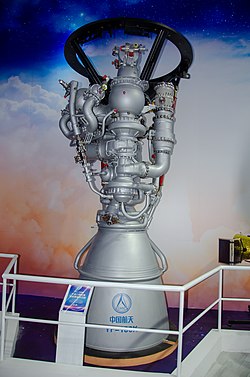 YF-100 rocket engine | |
| Country of origin | China |
|---|---|
| First flight | Long March 6 inaugural flight (2015-09-20) |
| Designer | Academy of Aerospace Liquid Propulsion Technology |
| Associated LV | Long March 5 Long March 6 Long March 7 Long March 8 Long March 12 |
| Predecessor | RD-120 |
| Status | In service |
| Liquid-fuel engine | |
| Propellant | LOX / RP-1 |
| Mixture ratio | 2.6 (±10%) (adjustable) |
| Cycle | Oxidizer-rich staged combustion cycle |
| Configuration | |
| Chamber | 1 |
| Nozzle ratio | 35 |
| Performance | |
| Thrust, vacuum | 1,340 kN (300,000 lbf) |
| Thrust, sea-level | 1,200 kN (270,000 lbf) |
| Throttle range | 65%~105% [1] |
| Chamber pressure | 18 MPa (2,600 psi) |
| Specific impulse, vacuum | 335 seconds (3.29 km/s) |
| Specific impulse, sea-level | 300 seconds (2.9 km/s) |
| Burn time | 155 s (estimated) |
| Dimensions | |
| Diameter | 1.338 metres (52.7 in) |
| Used in | |
| Long March 5 K-3-1 and K-2-1 boosters, Long March 6, Long March 6A, Long March 6C, and Long March 12 first stage and Long March 7, Long March 7A, Long March 8, and Long March 8A first stage and boosters. | |
| References | |
| References | [2] [3] [4] [5] [6] |
The YF-100 is a Chinese liquid rocket engine burning LOX and kerosene in an oxidizer-rich staged combustion cycle. [2] The engine is designed for use on the first stage of the Chinese government's new generation of launch vehicles, the Long March 5, the Long March 6 and the Long March 7. [7] [8] [9] The engine's maiden flight, on the Long March 6, took place on September 20, 2015.
Contents
Development of the engine began in the 2000s, along with its sibling, the smaller YF-115, which would power the upper stages of the Long March 6 and Long March 7 rockets. [7] [8] [9] Testing was directed by the China National Space Administration (CNSA) commencing in 2005. Development works are mainly carried out by the Xi'an Aerospace Propulsion Institute. The engine had its first 300 seconds test fire in November 2007. [10]
A high efficiency/high thrust environmentally-friendly rocket engine was always an objective within Programme 863 in the 1980s; however, Chinese industry was not mature enough at that time to produce such a rocket until they obtained RD-120s in early 1990 from Russia following the collapse of the USSR. [7] It is the first Chinese rocket engine to adopt the staged-combustion cycle and the most powerful to date. During July 2012 the engine fired for 200 seconds generating 120 t (260,000 lb) of thrust. [11] On May 28, 2012, the National Defense Science and Industry Bureau certified the engine. [12]

